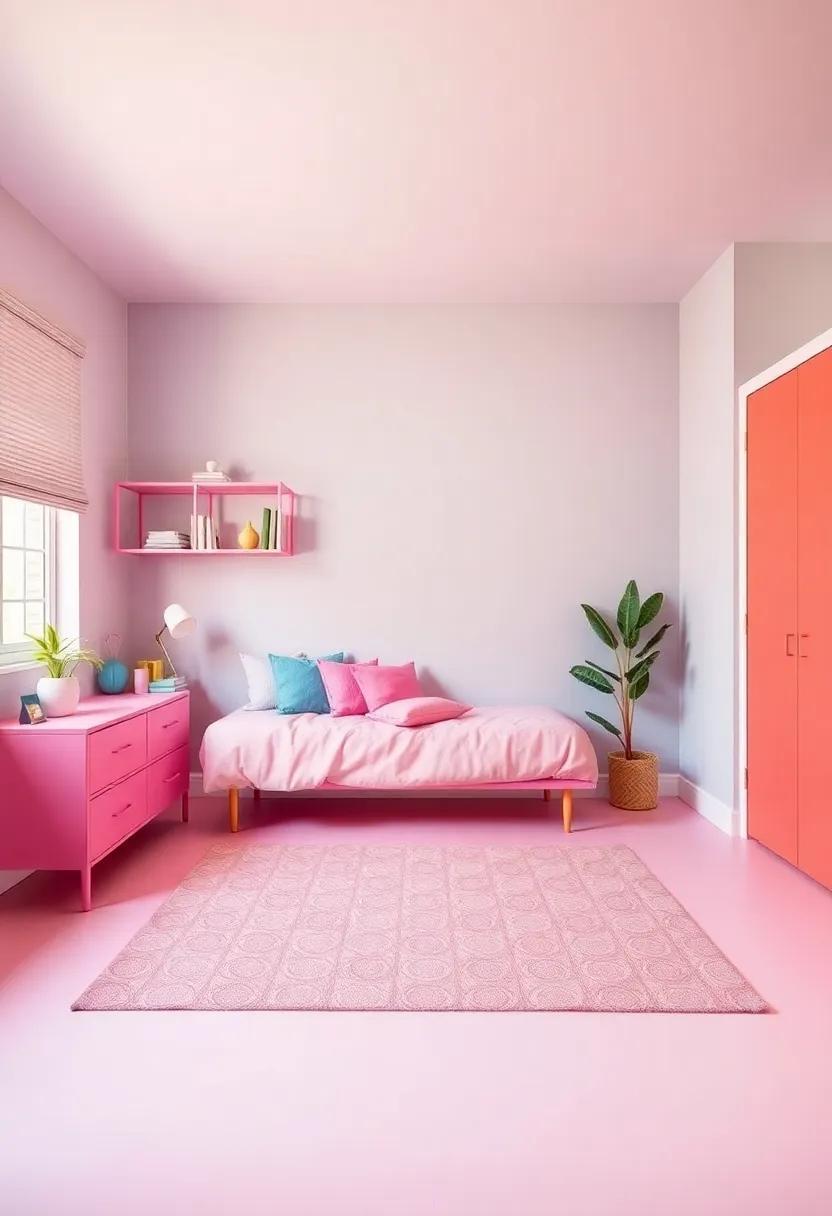In a world where self-expression reigns supreme, the importance of a personal sanctuary cannot be overstated, especially for teenagers navigating the whirlwind of adolescence. A vibrant room is more than just a space; it’s a reflection of identity, mood, and individual taste. With countless colors to choose from, each hue sets the tone for creativity and comfort, influencing both emotions and ambiance.In this extensive guide, we will explore the psychology behind color, offer inspiration for various themes, and provide practical tips to help transform any teen room into a vibrant oasis. Whether you’re drawn to bold statements or subtle shades, join us on a journey to discover how the right color scheme can transform a simple room into a vibrant expression of who you are.
Exploring the Psychology Behind Color Choices for Teen Room Spaces
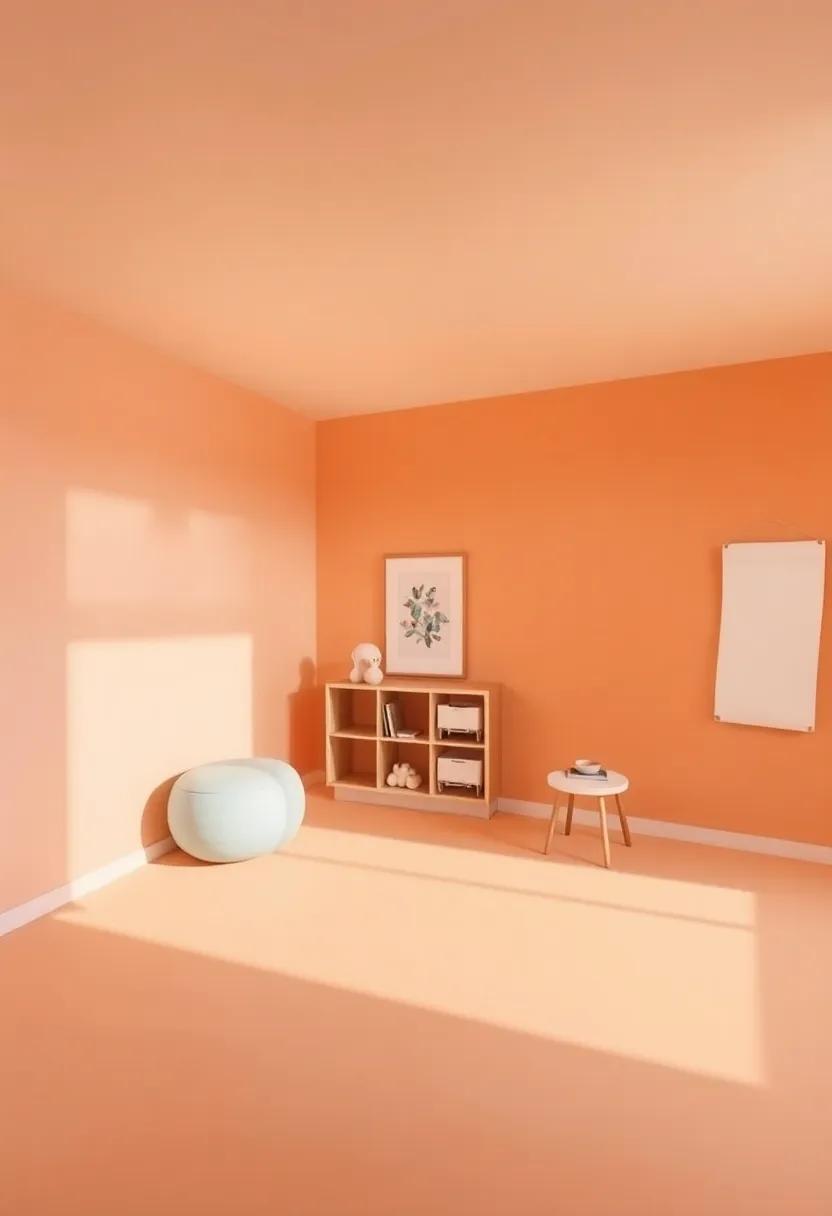
when it comes to designing a teenS room, the choices of color can greatly influence their mood and mindset. Colors are more than just superficial aesthetics; they evoke emotions and contribute to the overall ambiance of a space. For example, cool tones like blue and green are frequently enough associated with calmness and can create a serene surroundings for studying and relaxation, while warm hues such as red and orange may energize and inspire creativity. This interplay highlights the importance of understanding the psychological impact behind color choices,which can lead to a more harmonious living space for adolescents navigating the complexities of growing up.
Moreover, personal expression plays a significant role in how teens select colors for their sanctuaries. By allowing room for individuality, parents and guardians can encourage teens to choose colors that reflect their personality and aspirations. Here are some common colors and their associated traits to consider when collaborating with a teen on their room design:
| Color | Emotion/Association |
|---|---|
| Blue | Calmness, Stability |
| Green | Peace, Growth |
| Yellow | Happiness, Energy |
| Red | Passion, Excitement |
| Purple | Creativity, Imagination |
Encouraging teens to take charge of their color decisions can enhance their connection to the space. It provides an prospect for them to explore their identity and preferences in a safe, personal environment. as they experiment with patterns and shades, they develop a sense of ownership and pride in their room, turning it into a true reflection of who they are. for more insights into the psychology of color and its impact on spaces, visit Color Psychology.
Essential Color Wheel Basics for Crafting Stunning Teen Room Designs

Understanding the essentials of the color wheel can transform a basic room into a vibrant sanctuary for teens. At the heart of this transformation is the harmony of colors. The primary colors—red, blue, and yellow—serve as the foundation of every color palette. When blended,they create secondary colors such as green,orange,and purple,expanding your options substantially. To achieve balance, consider using complementary colors located directly opposite each other on the wheel. This approach can add contrast and excitement to the decor. another effective method is the analogous color scheme, where colors next to each other create a serene and cohesive look. This technique can help create a personalized space that resonates with the teen’s style and personality.
Pairing colors with the right embellishments is crucial. Here are some creative ways to utilize the color wheel effectively in teen rooms:
- Accent Walls: Choose a bold hue as an accent wall to inject energy without overwhelming the entire space.
- Textiles: Mix and match different shades of a single color family through bedding and curtains for a refined touch.
- Artwork and Decor: Incorporate prints, posters, or wall decals that reflect trendy color palettes, elevating the room’s vibe.
| Color Scheme Type | Effect |
|---|---|
| Monochromatic | Creates a calming and sophisticated atmosphere. |
| Complementary | Adds energy and excitement. |
| Analogous | Encourages harmony and peace. |
So, unleash the power of colors and inspire creativity in your teen’s space. For more detailed insights, explore HGTV as they offer extensive resources on interior design trends and color psychology.
Balancing Bold and Muted Tones: finding Your Ideal Color Harmony

Creating a striking visual aesthetic in a teen’s room involves weaving together bold and muted tones, striking a balance that embodies personality and vibrancy.Bold hues such as fiery reds, electric blues, and sunny yellows can be used as accent colors to invigorate the atmosphere, inviting energy and creativity. These colors work beautifully when combined with muted counterparts—soft pastels or earthy tones—creating a sense of calm and harmony. For instance, vivid teal walls paired with soft beige furnishings can create a dynamic space that doesn’t overwhelm the senses, making it a perfect retreat for relaxation and study.
to find your perfect harmony,consider using a color wheel to visualize complementary shades that can either enhance or soften your bold choices.Below is a simple table showcasing some ideal combinations:
| Bold Color | Muted Tone |
|---|---|
| Crimson Red | Soft Peach |
| Royal Blue | Light Gray |
| Lime Green | Powder Blue |
| Poppy Orange | Muted Olive |
Experimenting with various combinations will help you discover a palette that feels uniquely personal. For more insights into color theory and interior design, check out Colorado Virtual Academy to expand your knowledge further.
How to Create a Relaxing Atmosphere with Calming Color Palettes

Creating a serene environment begins with selecting a calming color palette that promotes relaxation and tranquility. Colors such as soft blues, gentle greens, and muted lavenders are often associated with serenity, making them perfect choices for a restful ambiance. To further enhance these shades, consider incorporating neutral accents. These can include light grays or soft whites that create balance and prevent the space from feeling overwhelming. Pairing cool tones with natural textures, like wood or fabric, can also amplify the soothing effect, turning your room into a personal oasis.
When it comes to wall treatments and decor, opt for paint finishes that reflect rather than absorb light. A satin or eggshell finish can definately help bring warmth to the calm colors, making the room feel inviting yet peaceful. Additionally, integrating various shades of the chosen color creates depth.For example, using a lighter version of blue for the walls with darker blue accents in furniture or decor can establish a cohesive look. To get inspiration for your color scheme, you might find valuable ideas and tools from Color Psychology.Remember, the goal is to choose a palette that resonates with you and fosters a comforting space to unwind and recharge.
Incorporating Favorite Hues: Making Personal Expression Shine Through
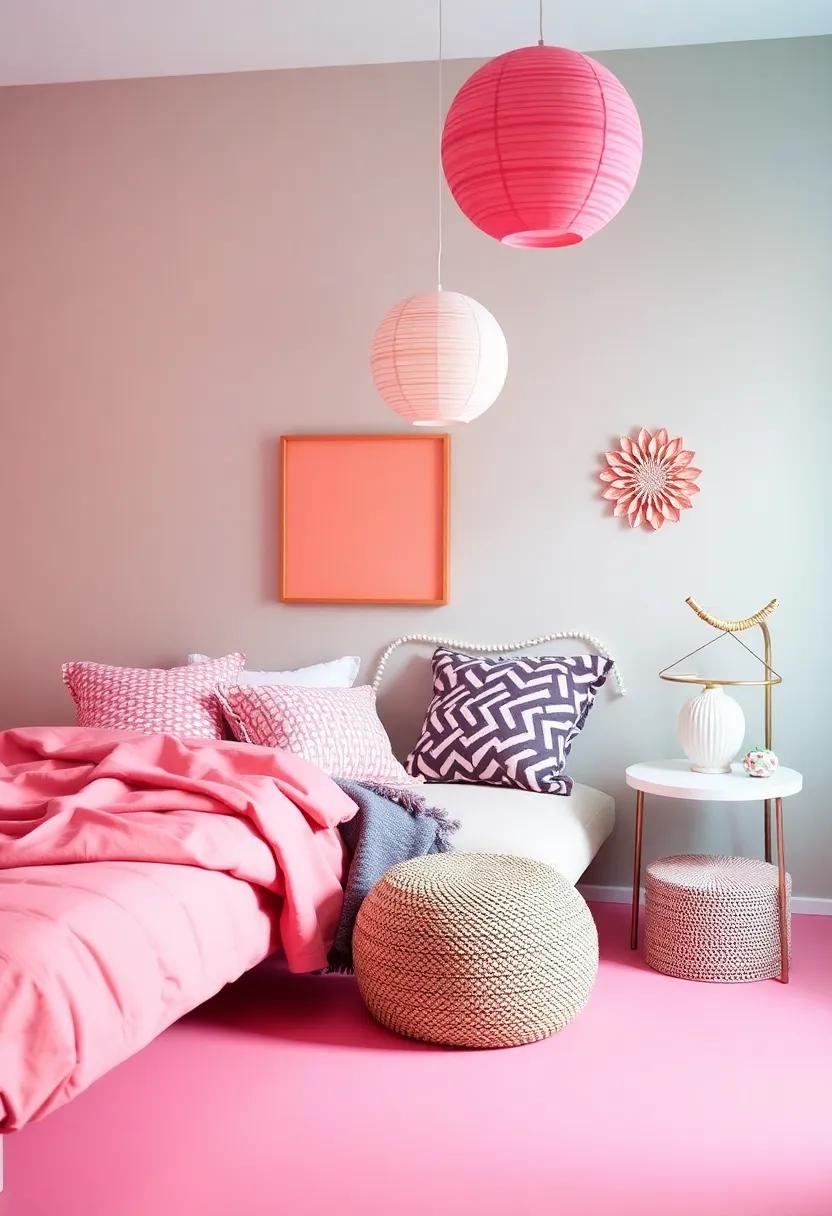
Choosing the right colors for your room can be a personal journey,reflective of your interests and passions. Embrace the hues that resonate most with you; whether its the calming essence of soft blues or the energetic vibe of vibrant yellows, every color has its own story to tell.Consider blending different shades to create a harmonious palette that speaks to your individuality. Here are some ideas to ignite your creativity:
- Monochromatic schemes: Use varying shades of a single color to create depth while maintaining a cohesive look.
- Contrasting colors: Pair bold colors like orange and blue to make each hue pop, showcasing your dynamic personality.
- Pastel combinations: Soft pastels can create a soothing environment, perfect for relaxation and focus.
- Accent walls: Choose one wall to make a bold statement, allowing the rest of the room to balance it out.
To help visualize your color combinations, consider creating a mood board. You can compile swatches, images, and decor ideas that echo your style. if you’re unsure which colors to use, why not explore interactive tools that many paint brands offer? They can help you simulate how different shades work together. To get started on your personal expression journey,check out Behr for inspiration and resources.
| Color Scheme | Emotion |
|---|---|
| Cool Blues | Calm & Serene |
| Bold Reds | Energy & Passion |
| Soft Pastels | Peace & Tranquility |
| Sunny Yellows | Joy & Optimism |
Trendy Color Combinations That Energize a Teen’s Living Space
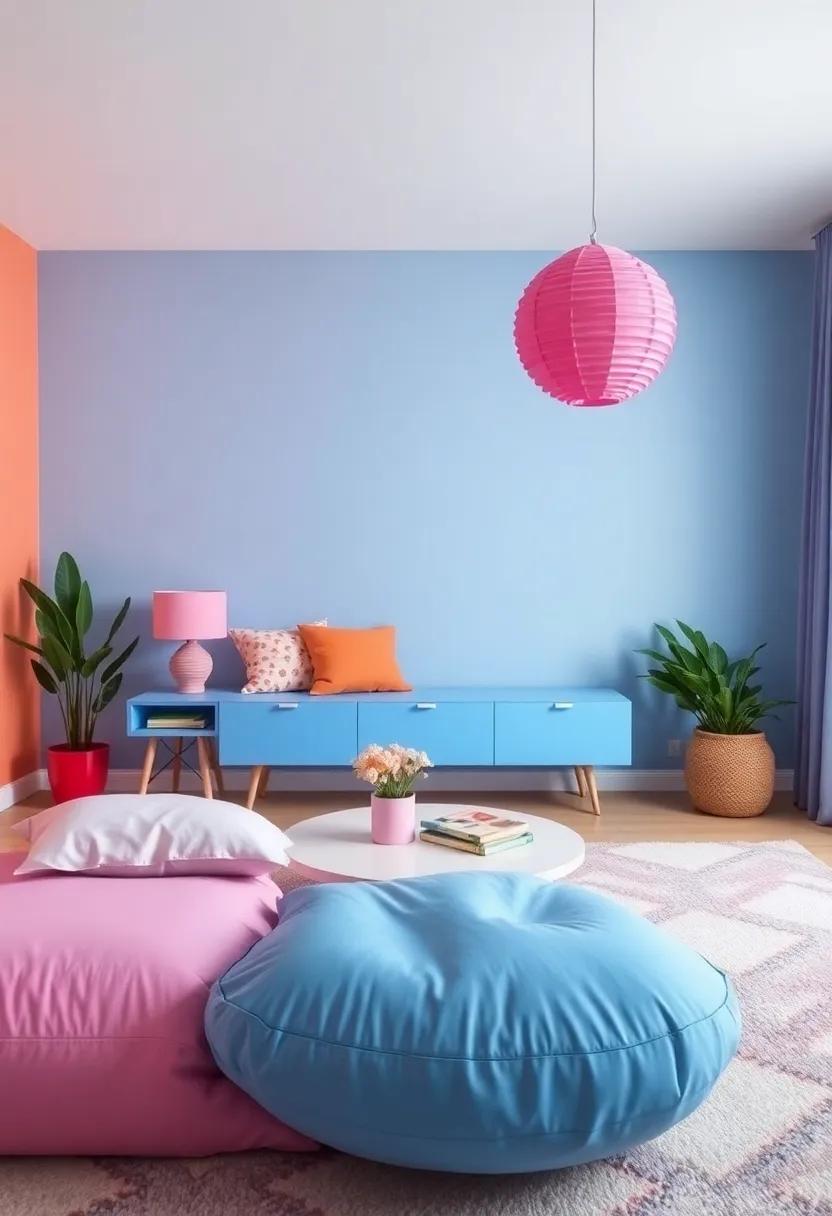
When it comes to creating a vibrant and energetic living space for teens, color combinations can play a pivotal role. One exciting pairing is turquoise and coral, which exudes a fresh and lively atmosphere. Turquoise can be incorporated through accent walls or decorative items, while coral can add a touch of warmth through textiles like pillows or blankets. Another lively duo is lime green and electric blue; these colors bring a sense of vitality and fun. Consider using lime green for large furniture pieces, with electric blue accents in artwork or rugs, creating a striking contrast that invigorates the space.
For those who prefer a more balanced yet dynamic feel,the combination of soft lavender and sunny yellow creates a cozy and inviting environment.The calming influence of lavender paired with cheerful yellow accents can lighten up any room. Alternatively, the bold clash of magenta and mustard can be a daring yet delightful choice for those looking to make a statement. With magenta featured in decorative elements and mustard in larger furnishings, this combo can captivate and energize any teen space. For more inspiration on color palettes, consider exploring Color Adobe.
Utilizing accent Walls to Enhance Style without Overpowering the Room
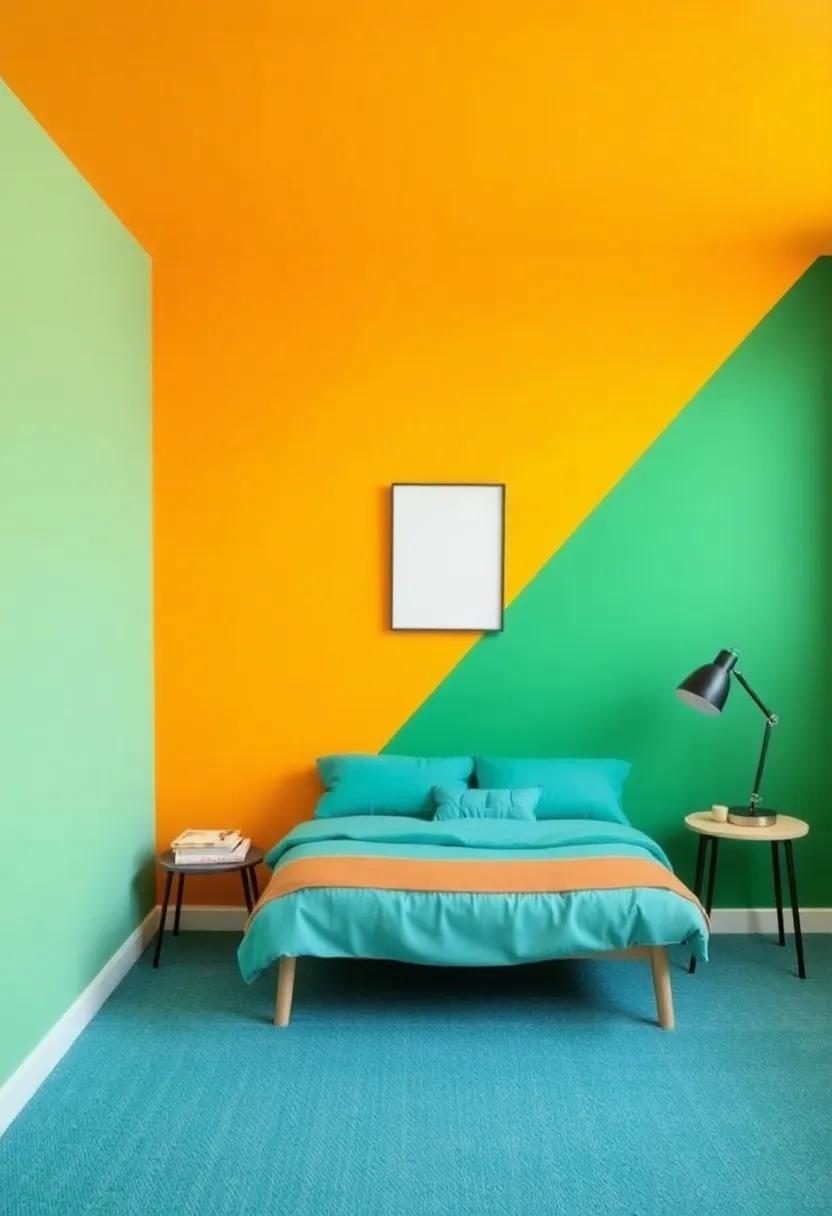
accent walls are a fantastic way to introduce a splash of personality and style to a teen’s room without overwhelming the entire space. By selecting a bold color or an interesting pattern for just one wall, you can create a focal point that draws the eye while allowing the rest of the room to maintain a balanced aesthetic. Some popular choices for accent walls include deep shades like navy blue or emerald green, which can provide a sense of sophistication and calm, or vibrant hues like coral or mustard yellow for a more energetic vibe. Consider the following elements when planning your accent wall:
- Color Theory: Complementary colors can make the accent wall pop.
- Pattern Play: Stripes, polka dots, or geometric designs can add additional interest.
- Artwork Placement: Create a gallery wall around the accent to enhance its visual appeal.
To ensure that the accent wall harmonizes with the overall decor of the room, you can coordinate the colors with furniture or textiles.Accessories like cushions, rugs, or curtains can echo the color of the accent wall, creating a cohesive look. A well-placed mirror can also reflect light and create an illusion of more space, adding depth to the room without competing with the vibrant colors.Explore additional tips and inspiration for your creative journey at houzz.com and transform your teen space into a haven of style.
Embracing Nature: Earthy Tones That Bring the Outdoors Inside
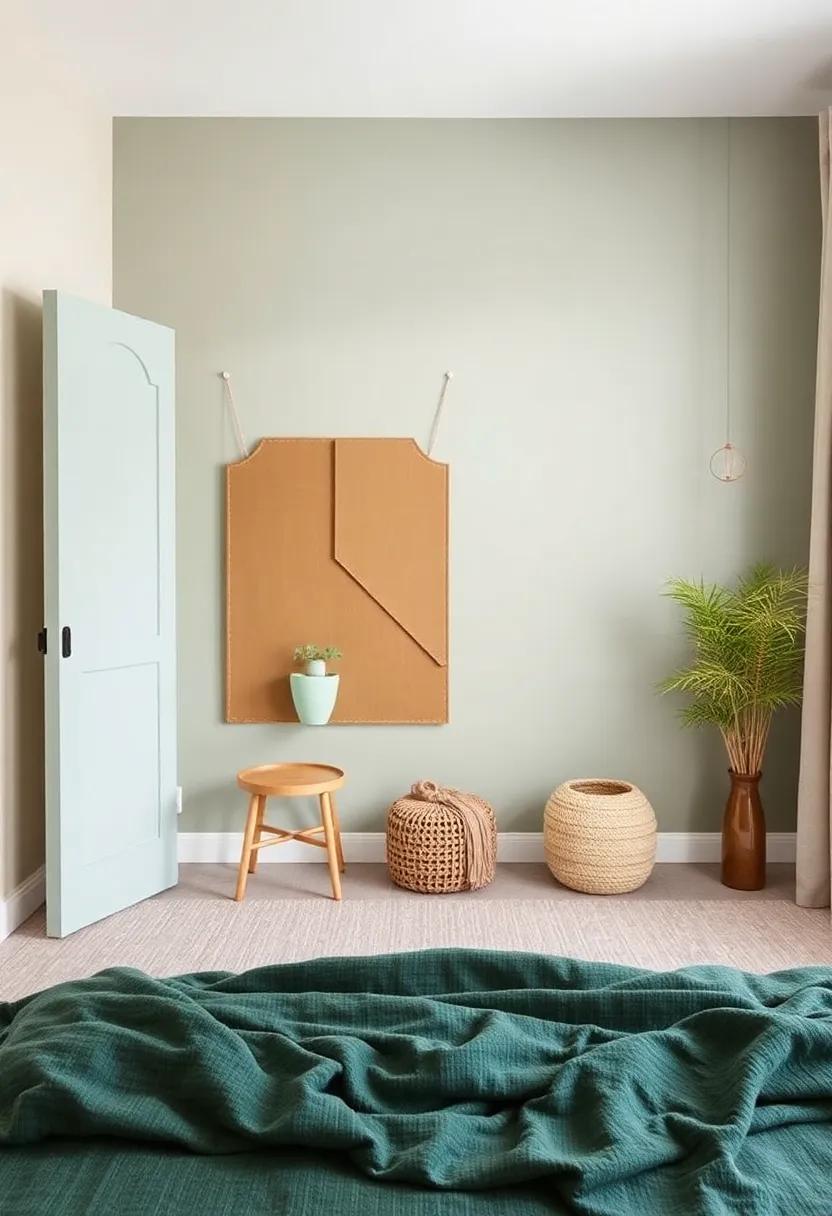
Creating a serene space that reflects the natural world can uplift a teen’s room, making it a sanctuary of calm and inspiration. By incorporating earthy tones like sage green, terracotta, and soft beige, you can evoke the feeling of being outside, surrounded by lush landscapes. These colors not only foster a sense of tranquility but also encourage creativity and self-expression.Pairing warm earth tones with natural textures such as wood, linen, and stone can further enhance the aesthetic, creating an inviting environment that feels both grounded and refreshing.
To effectively utilize these hues, consider introducing them through various elements in the room. Here are some ideas:
- Accent walls painted in calming greens or soft browns
- Bedding and curtains in natural fabric blends with organic textures
- decorative accessories, like cushions or wall art, showcasing earthy patterns
- Plants that bring a splash of life and enhance the connection to nature
To see more inspiration, visit Houzz for fantastic ideas on integrating earthy tones into modern teen rooms.
The Impact of Lighting on Your chosen Colors: Brightening Up Spaces
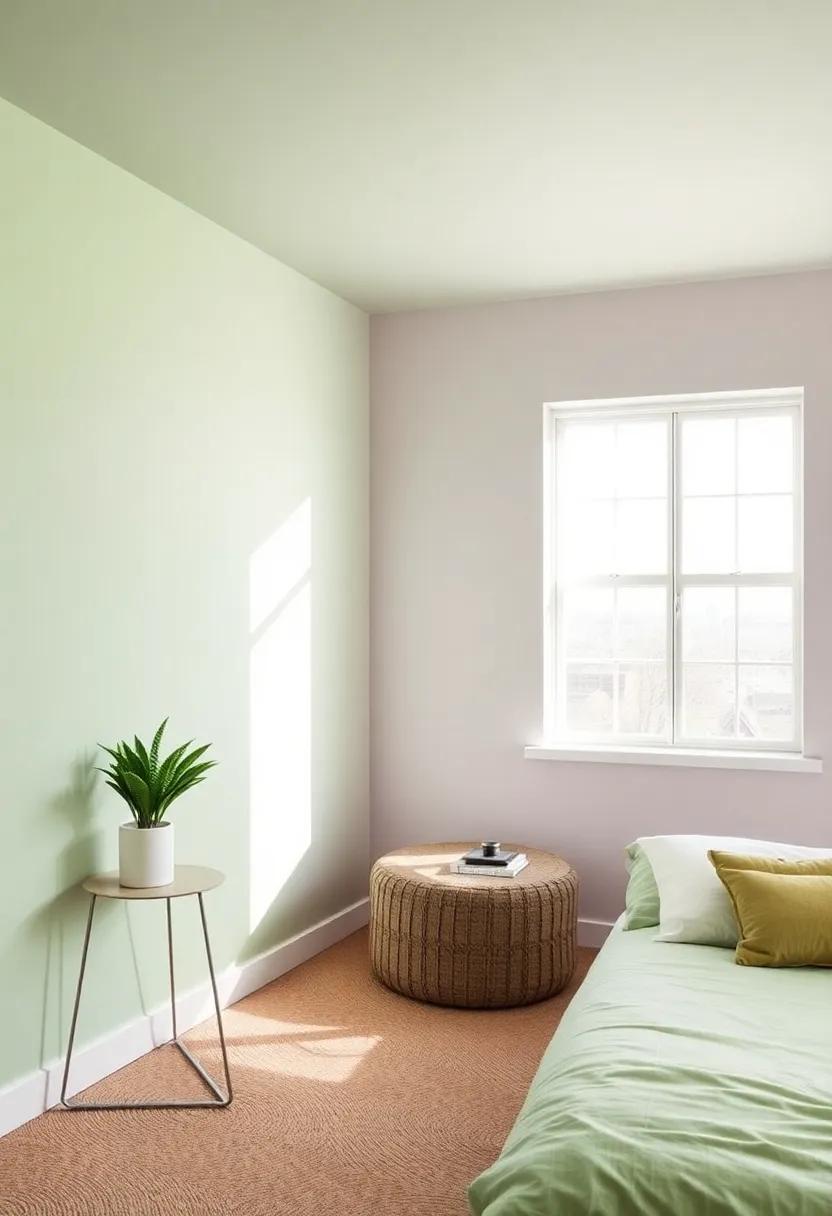
Lighting plays a pivotal role in how colors are perceived in any space, and when it comes to a teenager’s room, it can transform the ambiance and mood dramatically.Different types of lighting can bring out various hues in your chosen color scheme. For example, natural light can enhance warmer tones such as yellows and oranges, making them look vibrant and inviting. In contrast, cooler artificial lights can elevate blues and greens, creating a serene atmosphere. To make the most of your colors, consider using a combination of light sources:
- Ambient Lighting: Provides overall illumination, perfect for daytime use.
- Task Lighting: Focused light for specific activities, enhancing areas like desks.
- Accent Lighting: Highlights artwork or specific features in the room, adding depth.
Experimenting with different color pairings under various lighting can yield interesting results. As an example, a vibrant pink wall might appear softer under dimmed lighting, creating a cozy nook, while radiant white light can make it pop, suited for more energetic activities. It’s beneficial to create a lighting plan that complements your chosen colors and fulfills your functional needs. Consider utilizing a wide spectrum of bulbs, and explore putting your lighting on dimmer switches to easily adjust the atmosphere as needed.For inspiration on decorating with color and light, check out The Spruce.
Seasonal Colors: Refreshing Your teen’s Room with Changing Palettes
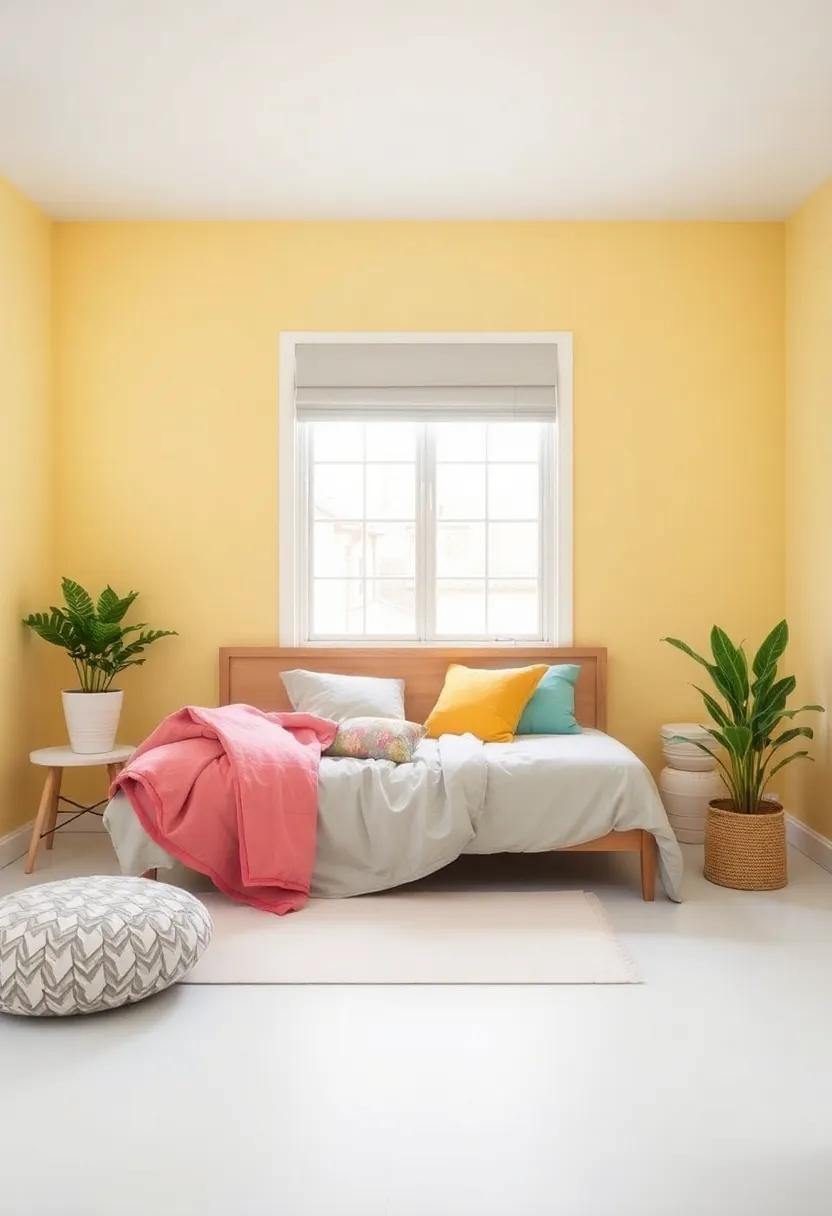
Incorporating these fresh palettes doesn’t require a complete overhaul of the room. You can opt for removable wallpaper, colorful bedding, or even a few carefully chosen accessories to bring the seasonal vibe without a permanent commitment. Some practical ideas include:
- Seasonal Art: Swap out framed prints or wall decals to reflect the current season.
- Pillows and Throws: Change cushions and blankets to match the color of the season.
- Accent Furniture: Consider using small pieces like chairs,ottomans,or side tables in seasonal shades.
- DIY Projects: Encourage your teen to create their own art or decorations that align with the seasonal theme.
By thoughtfully changing up the colors, not only do you keep the room feeling alive and engaging, but you also allow your teen to express their personality and creativity throughout the year. For more inspiration on color schemes and room decor ideas, visit Decoraid for some fabulous concepts!
Combining Patterns and Colors: A Guide for Teen Rooms
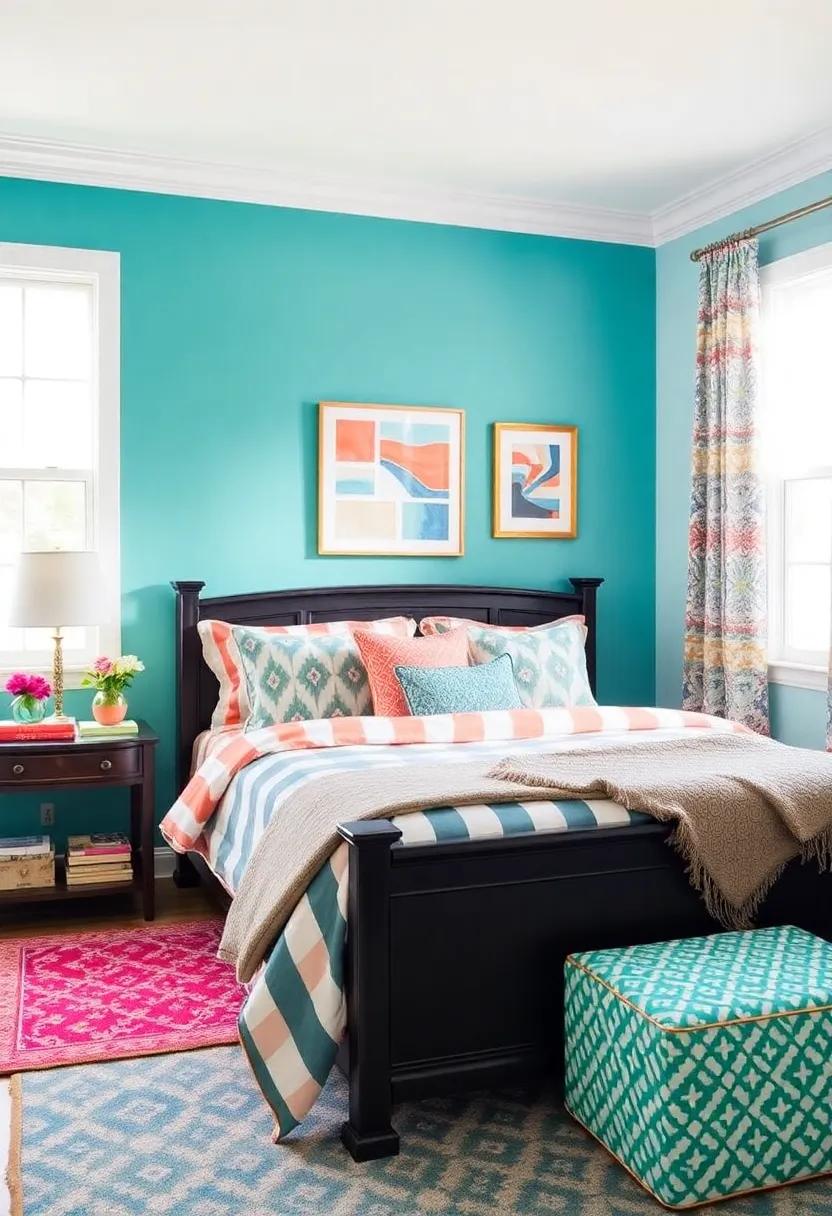
Creating a stunning teen room with multiple patterns and colors can feel overwhelming, but it’s all about finding the right balance. Start by choosing a dominant color that resonates with your teen’s personality. As an example, shades like turquoise or coral can evoke a fun, refreshing vibe. then, layer in complementary hues through various elements such as bedding, curtains, and artwork. Consider incorporating patterns that add texture and intrigue to the space; geometric designs or florals offer unique visual interest when paired correctly. Use a consistent color palette to maintain harmony across all elements.
To make the most of patterns, think of using different scales and types. Such as, bold stripes can anchor a room, while smaller prints are perfect for accent pieces. It’s important to mix materials as well, such as combining bold prints with softer fabrics. Here’s a simple checklist to help strategize your design:
- Choose a main color for walls.
- Select 1-2 patterns for textiles (bedding, curtains).
- Add accent colors through decor (pillows, rugs).
- Incorporate fun elements (posters, wall art).
- Ensure a cohesive look by repeating a color in different elements.
| Color | Pattern | Effect |
|---|---|---|
| Turquoise | Geometric | Modern & Fresh |
| Coral | Floral | Vibrant & Cheerful |
| Grey | Stripes | Classic & Timeless |
By carefully selecting your colors and patterns, you can create a teen room that feels curated and lived-in. For more inspiration,check out House Lovely for unusual ideas to elevate the space.
Color Psychology as a Tool for Creating Productive Study Areas
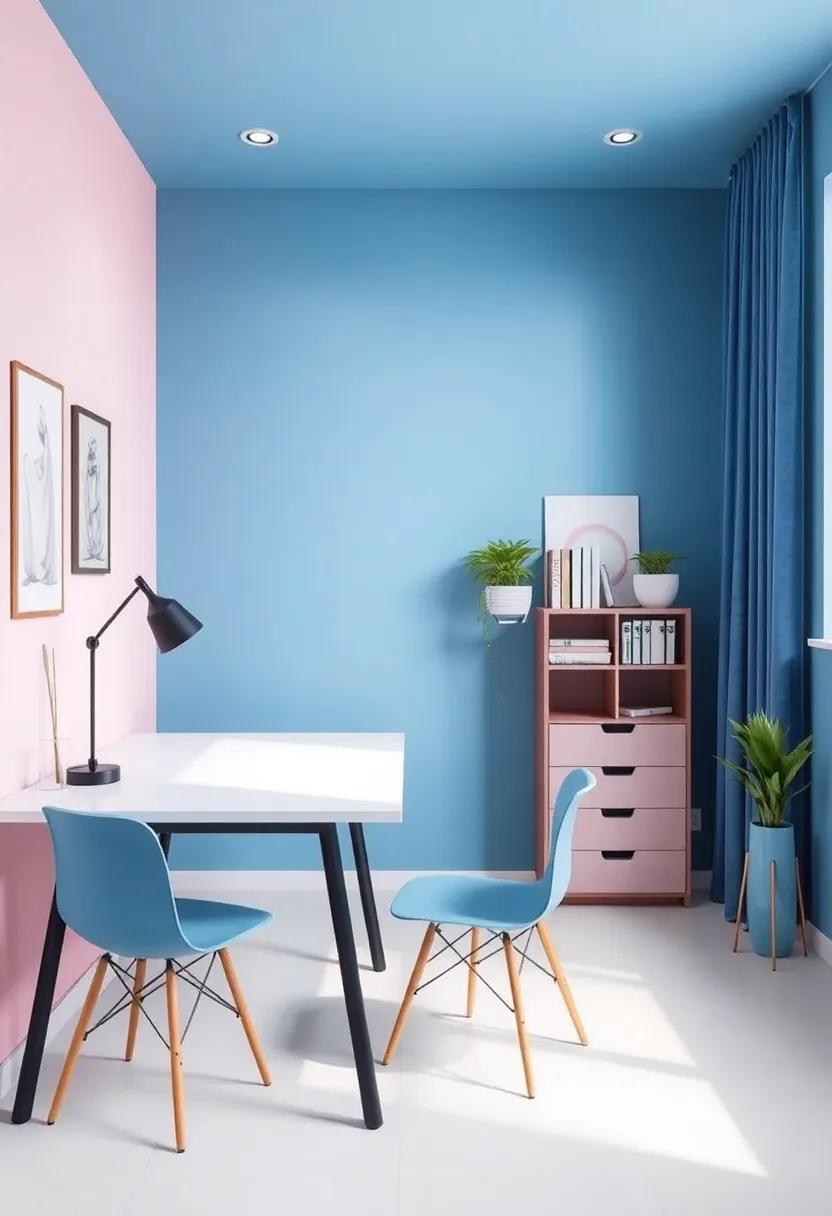
Creating an effective and engaging study area goes beyond just organizing books and materials; it’s also about the environment in which you work. The right color scheme can significantly influence mood, focus, and productivity. For instance, blue hues tend to promote calmness and concentration, making them ideal for study environments.Meanwhile, yellow can invoke feelings of cheerfulness and energy, which might be beneficial during creative brainstorming sessions.When designing a study space,consider incorporating these colors in various ways,such as through wall paint,accessories,or even furniture. A harmonious blend of colors can create an inviting atmosphere conducive to learning.
To harness the power of color psychology effectively, it’s essential to understand the emotions that different colors evoke. Here’s a simple table that outlines some common colors and their psychological impacts:
| Color | Psychological Impact |
|---|---|
| Blue | Promotes calmness, focus, and intellect. |
| Green | Fosters tranquility and balance. |
| Yellow | Enhances creativity and happiness. |
| Red | stimulates energy and attention. |
| Purple | Encourages creativity and imagination. |
By strategically incorporating these colors and understanding their effects, you can create a space where creativity flows and productivity thrives. For more insights on color psychology and how it can impact various aspects of life, check out Color Psychology.
Nurturing Creativity with Vibrant and Playful color Schemes
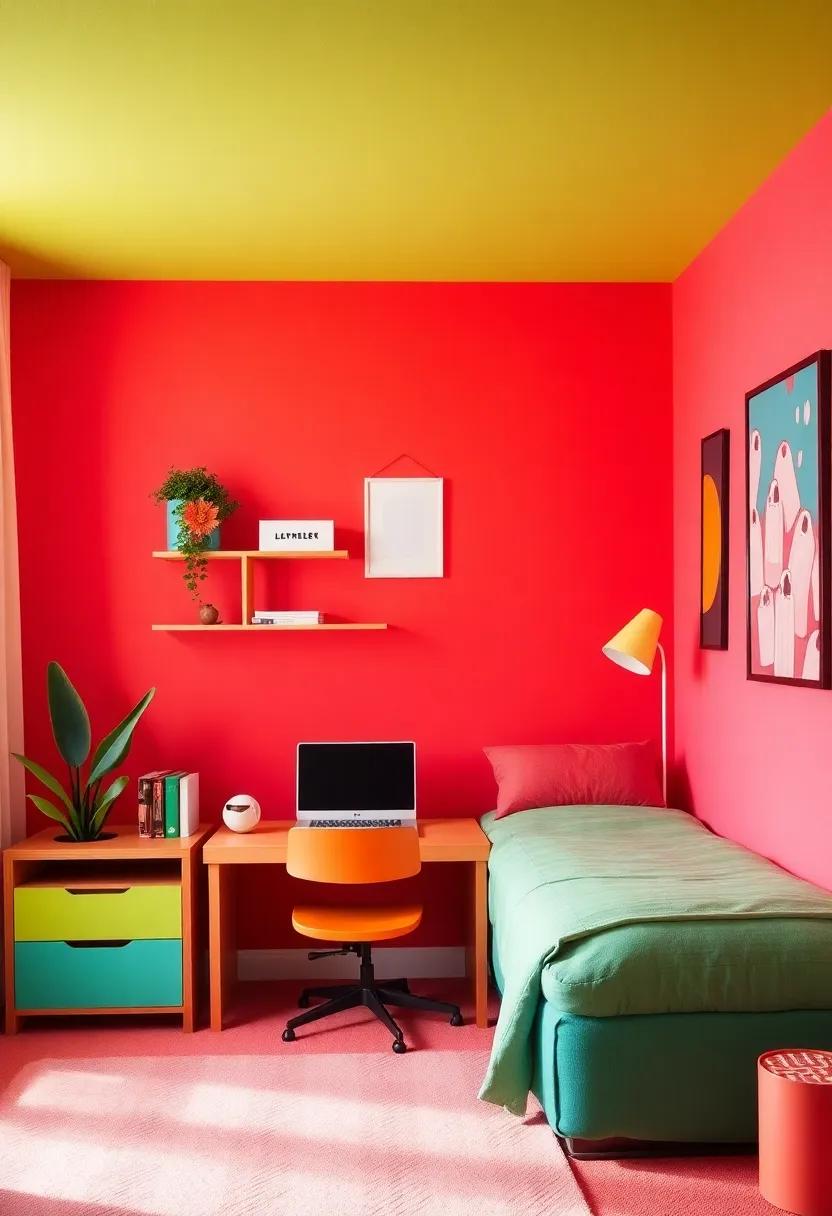
Embracing vivid hues can turn an ordinary teen room into a canvas of imagination and energy. When opting for playful color schemes, it’s essential to consider combinations that evoke joy and inspiration. A cheerful palette can spark creativity, offering an inviting backdrop for homework and relaxation alike. consider experimenting with colors like sunny yellows, vibrant pinks, and cool teals. These shades not only foster a sense of playfulness but also create a welcoming atmosphere. The key is to balance bold shades with softer neutrals, ensuring that the room remains harmonious and not overwhelmingly bright.
To make the most of your chosen colors, think about incorporating different textures and patterns within the space. Use playful accents such as throw pillows, wall art, or even a colorful area rug to accentuate the primary color scheme. Here are some vibrant color pairings to consider:
| Color Scheme | Best For |
|---|---|
| Sunny Yellow & Ocean Blue | Bright, cheerful vibes |
| Hot Pink & Mint Green | Trendy and youthful flair |
| Purple & Teal | Creative and calming space |
| Coral & Turquoise | Fun, energizing atmosphere |
For more inspiration on color schemes and design ideas, visit Color Psychology where you can dive deeper into how colors influence mood and creativity.
The Role of Neutrals in Balancing Bright Colors in Teen Spaces
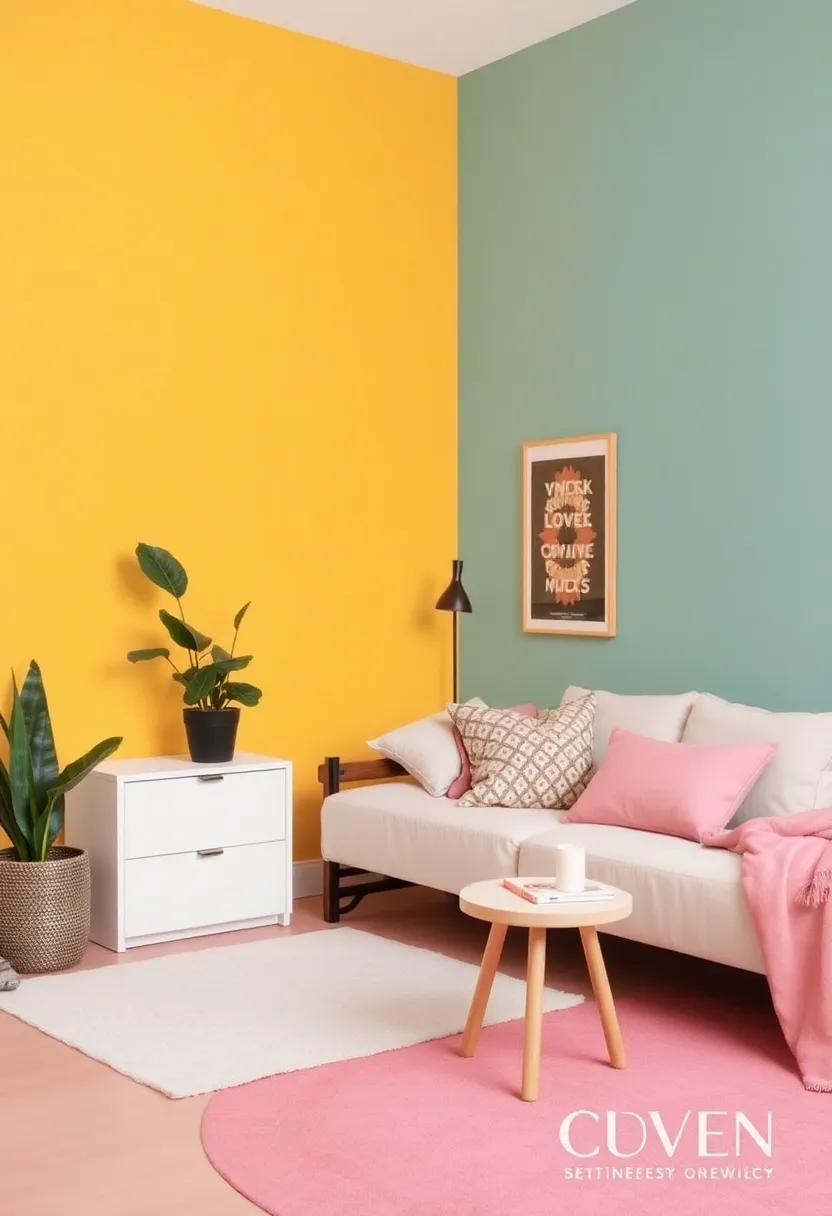
When designing a teen room filled with vibrant hues, it’s essential to recognize the balancing power of neutral tones. Neutrals serve as a backdrop that allows bold colors to truly pop without overwhelming the senses. they create a calm foundation upon which bright colors can dance, ensuring that the vibrant aspects of the space remain inviting rather than chaotic. In this context,consider incorporating elements like beige,white,grey,and taupe through walls,furniture,or accents. This subtle grounding not only enhances the visual harmony but also provides flexibility for future changes in decor without clashing.
Moreover, neutrals can help delineate areas within a multi-functional teen space, creating zones for relaxation, study, or creativity. By strategically placing neutral colors in furniture or design elements, such as a comfortable sofa or a cozy rug, one can enhance the effectiveness of vibrant accents like a colorful artwork or bright pillows. To illustrate how neutrals can beautifully complement brighter shades, here’s a simple table highlighting color pairs:
| Bright Color | Neutral Companion |
|---|---|
| Electric Blue | Soft Grey |
| Vivid Yellow | Warm Beige |
| Hot Pink | Crisp White |
| Lime Green | Cool Taupe |
By thoughtfully combining vibrant colors with these neutrals, teens can create spaces that are not only lively and full of personality but also harmonious and relaxing, fostering an environment that supports both study and leisure. For more inspiration on color combinations, visit Color Box Design.
Transformative Color Ideas for Small Teen Rooms on a Budget
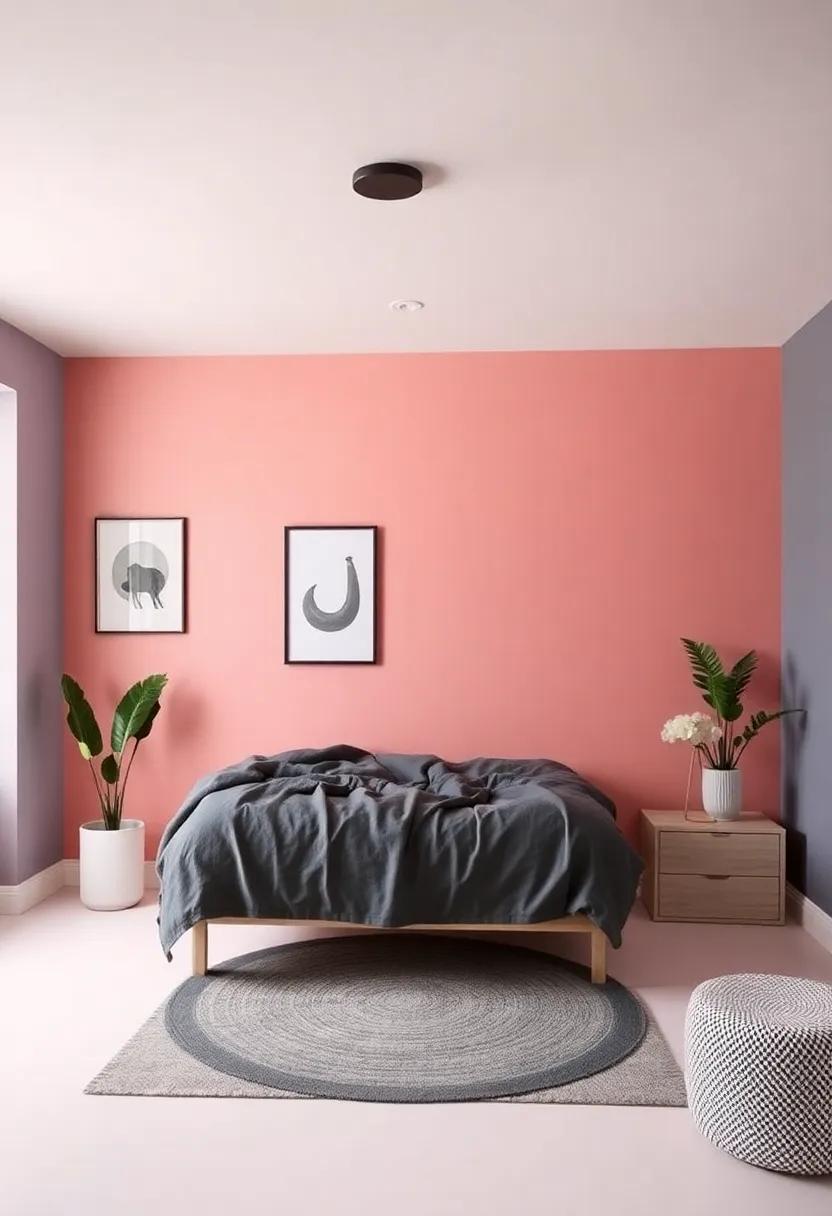
Transforming a small teen room doesn’t have to break the bank, and the right color choices can dramatically alter the feel of the space. One bold idea is to utilize accent walls to create a focal point without overwhelming the entire room. Choose a vibrant color like turquoise or coral for one wall, adding depth and character, while keeping the remaining walls in a soft neutral shade. This approach not only makes the space appear larger but also allows for playful decor elements that can pop against the backdrop. Coupling this with color-coordinated furniture—think shelf units or bedding in complementary hues—creates a cohesive look that feels intentional and stylish.
For a budget-friendly twist, consider using removable wallpaper or peel-and-stick decals for an aesthetically pleasing design. These options offer variety without commitment, perfect for a teen’s ever-evolving tastes. Incorporating bold patterns or textures in your color scheme can jazz up the room while avoiding the permanence of paint. Additionally, bright accessories like rugs, curtains, and throw pillows in assorted vibrant colors can be easily swapped out seasonally or whenever the mood strikes. Here are a few budget-conscious color ideas for walls:
| Color | Vibe | Best Pairings |
|---|---|---|
| Soft Lavender | Calm & Dreamy | White, Silver, Pastels |
| Sunshine Yellow | Cheerful & Energetic | Gray, Navy, Teal |
| Bold Red | Passionate & Dynamic | black, White, Cream |
For more inspiration, check out apartment Therapy for tips on DIY decor and innovative color pairings that can refresh any small space effortlessly.
Inspiration from Pop Culture: Color Trends for the Modern Teen
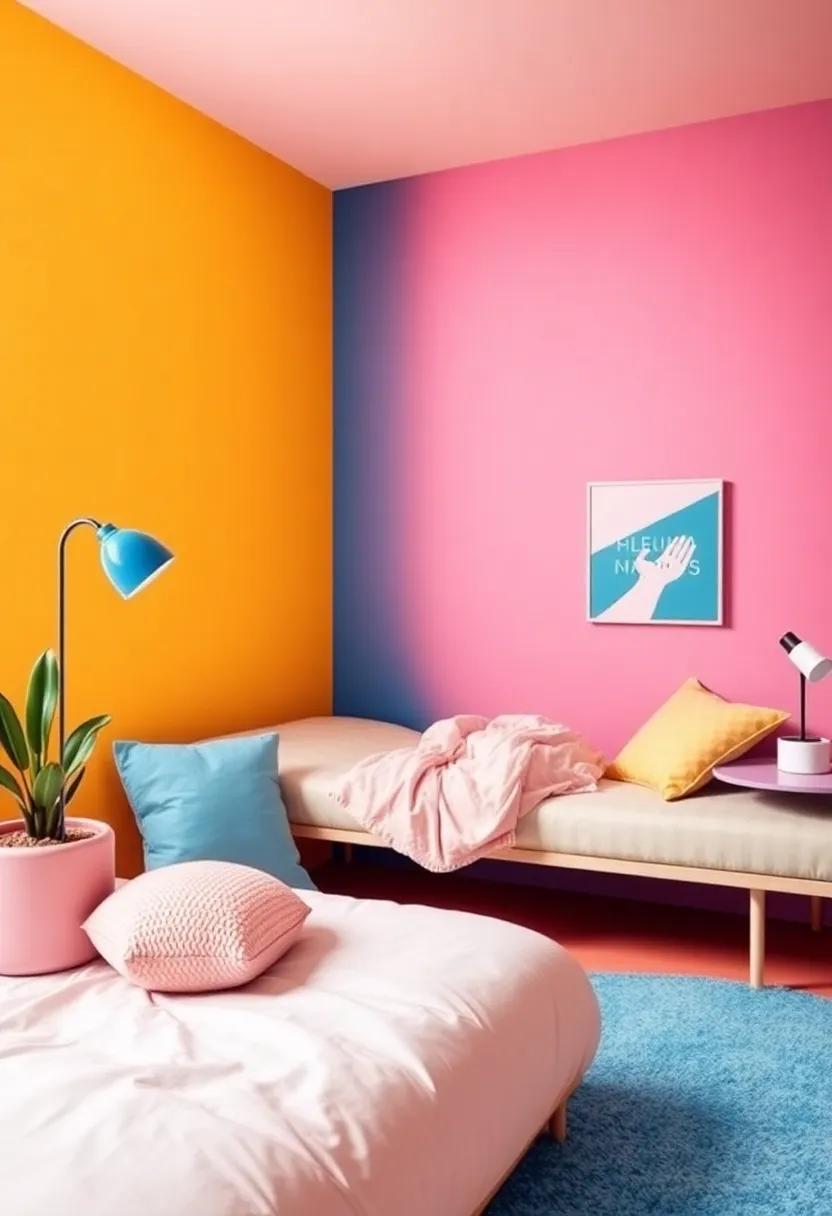
Pop culture has a remarkable ability to influence the aesthetics of our lives,especially when it comes to bedroom design for teens.In recent years, we’ve seen a surge of vibrant colors inspired by popular movies, music, and social media trends. For instance, the pastel color palette showcased in romantic comedies can inspire soft yet striking combinations. These include shades like lavender, baby blue, and soft pink, perfect for creating a dreamy, cozy atmosphere. Additionally, bold colors reminiscent of superhero flicks, such as electric blue, fiery red, and neon green, resonate with a sense of adventure and individuality, inviting teens to express their unique personalities through their space.
Another exciting trend emerges from the realm of video games and anime, blending dynamic hues to create immersive environments. the use of glow-in-the-dark paint and LED lights can transform a room into an interactive experience that reflects the vibrant landscapes of their favorite games.To harness this dynamic energy, consider pairing deeper shades like midnight navy or forest green with pops of bright yellow or coral. This can be achieved through accent walls or accessories like bedding and wall art. Here’s a quick summary of trending colors and their pop culture origins:
| Color | Inspiration |
|---|---|
| Pastel Lavender | Romantic comedies |
| Electric Blue | Superhero Movies |
| Fiery Red | Action Films |
| Forest Green | Adventure Games |
| Neon Coral | Social Media influencers |
These influences not only help in choosing the right shades but also encourage teens to embrace an expressive and lively ambiance. To stay updated on the latest trends and how to incorporate them creatively, explore resources such as decoist.com.
Personalizing Spaces with Color: Adding Unique Touches to Walls

Transforming walls can truly personalize a space and infuse it with energy. Bold hues like electric blue or vibrant coral can create a fantastic backdrop,while softer shades like mint green or lavender lend a calming effect.Consider incorporating unique patterns or textures using techniques such as stenciling or sponge painting. Accessorizing with wall decals or intricate wall art that reflects personal interests can also elevate the aesthetic, bridging the gap between color and character. A few ideas to consider include:
- Accent walls in rich colors to create a focal point.
- Multi-layered wall treatments combining paint with wood or fabric.
- Custom murals that tell a story or express individuality.
Think about the lighting in the room, as it can dramatically impact how colors appear. Warm lighting can make colors feel cozier, while cooler lighting allows for vivid expressions. Additionally, utilizing reflective surfaces, such as mirrors or metallic finishes, can amplify natural light and enhance the overall vibrancy of the design. For a practical approach, it may be worth exploring color placement strategies. Organizing a simple table of complementary and contrasting colors can help in making informed choices:
| Base Color | Complementary Color | Contrasting Color |
|---|---|---|
| Soft Blue | Coral | Mustard yellow |
| Light Gray | Turquoise | Crimson Red |
| Pale Peach | Teal | Deep Purple |
For more inspiration,exploring resources like The Art of Living can provide additional insights into creating a vibrant and personalized environment that resonates with individual style.
Exploring Global Color Influences in Teen Room Decor

When it comes to teen room decor, color is more than just an aesthetic choice; it reflects personal interests, identities, and even cultural influences. Globally,color schemes vary widely,shaped by cultural significance and environmental elements. As a notable example, in Scandinavian countries, soft pastels like mint green and blush pink dominate, creating serene spaces that foster relaxation. Conversely, bold colors such as cobalt blue and fiery red are popular in many Asian countries, symbolizing energy and enthusiasm. Integrating these colors can create a sense of global awareness and inspire creativity in a teen’s personal sanctuary.
Incorporating a variety of colors from different cultures can enhance the dynamism of a teen’s room. Here are some popular color influences to consider:
- Moroccan Mosaic: Rich jewel tones like turquoise, deep orange, and radiant yellow.
- Japanese Minimalism: Neutral shades paired with a splash of vibrant hues like cherry blossom pink.
- South American Spirit: Bright green and bold purple, energizing the space.
- African Earth Tones: terra-cotta, ocher, and forest green evoke a natural vibe.
Each of these influences can be thoughtfully combined to create a cohesive design that resonates with a teen’s lifestyle and cultural thankfulness. For further inspiration, discover a range of color palettes at Color Psychology.
Cool vs Warm colors: Setting the Mood for Teen Relaxation or Energizing

Colors play a crucial role in shaping the atmosphere of a space, particularly in a teenager’s room where relaxation and energy can toggle throughout the day. Cool colors, such as blues, greens, and purples, tend to promote calmness and tranquility, making them ideal for rest and recovery after the hustle and bustle of school or social life. these shades can create a serene environment conducive to studying or meditation, allowing teens to recharge their minds. adding touches of neutral tones or soft pastels can enhance this feeling of tranquility, turning the room into a personal oasis. Consider incorporating elements like a soothing sea-blue on the walls or an inviting lavender throw blanket to accentuate these calming vibes.
On the other hand, warm colors like reds, oranges, and yellows, can invigorate and energize the space, sparking creativity and enthusiasm. These vibrant hues are ideal for areas where socializing and activities take place, creating an uplifting environment that encourages dialog and connection. A splash of warm color through an energetic accent wall or a bright area rug can infuse the room with life and excitement. Strategically mixing warm tones with inviting neutrals provides a balance that fosters both relaxation and energized interactions. For a lively mix,consider using a chart like the one below to visualize how to blend these elements effectively:
| Color Type | Examples | Intended Mood |
|---|---|---|
| Cool | Blue,Green,purple | Calm,Relaxed |
| Warm | Red,Orange,Yellow | Energetic,Invigorating |
Understanding the balance between these color schemes provides an opportunity to tailor a teen room to suit personal preferences and activities. For more inspiration on creating the perfect ambiance through color, visit Color Psychology.
How to Use Color to Define Zones in a Shared Teen Room
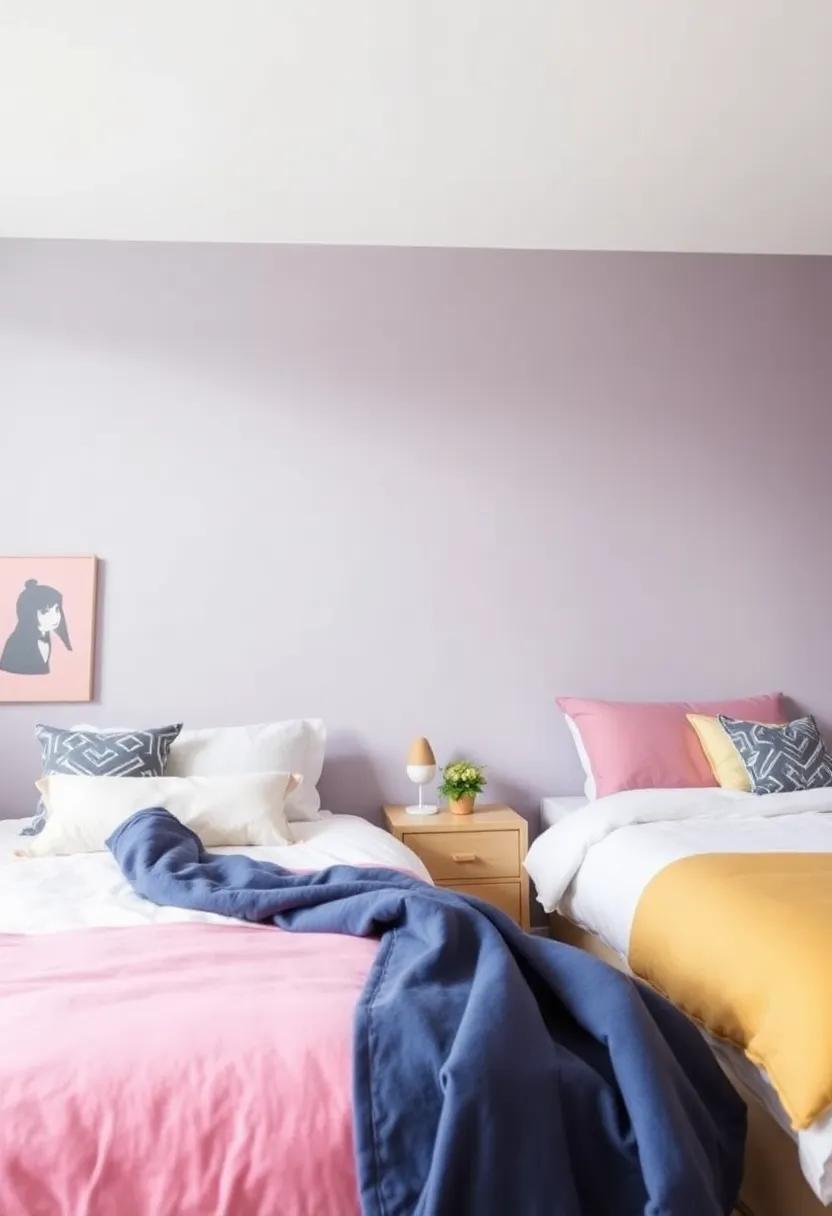
Utilizing color to delineate zones in a shared teen room can foster a harmonious yet individualized space for both occupants. Start by selecting a primary color palette that resonates with both teens, ensuring that it adheres to their preferences while remaining versatile. As a notable example, a soft blue could serve as a calming backdrop throughout the room. Next, define specific areas using complementary or contrasting colors. Position a vibrant orange around a study nook to boost concentration,while a refreshing green could frame a relaxation corner,promoting tranquility. Using wall decals or furniture in these distinct colors can further enhance the separation of zones without major renovations.
To effectively use color, consider incorporating furniture and accessories as additional tools for definition. Such as, a shared bed can have colorful throw pillows respective to each teen’s taste, while bookshelves can be painted in two distinct colors, each representing personal territories. When applying this method, maintain a balance to avoid a chaotic appearance; neutral tones can intersperse brighter zones to create cohesion. Here’s a simple guide to visualize how color can define individual spaces within a shared room:
| Zone | Color | Purpose |
|---|---|---|
| Study Area | Vibrant Orange | To energize and focus |
| Relaxation Space | Soft Green | To promote calmness |
| Sleep Area | cool Blue | To create a tranquil environment |
| creative Zone | Bright Yellow | To inspire creativity |
For further inspiration on creating harmonious spaces, take a look at Apartment Therapy.
The Best Color Combinations for Enhancing Natural Light in Teen Rooms
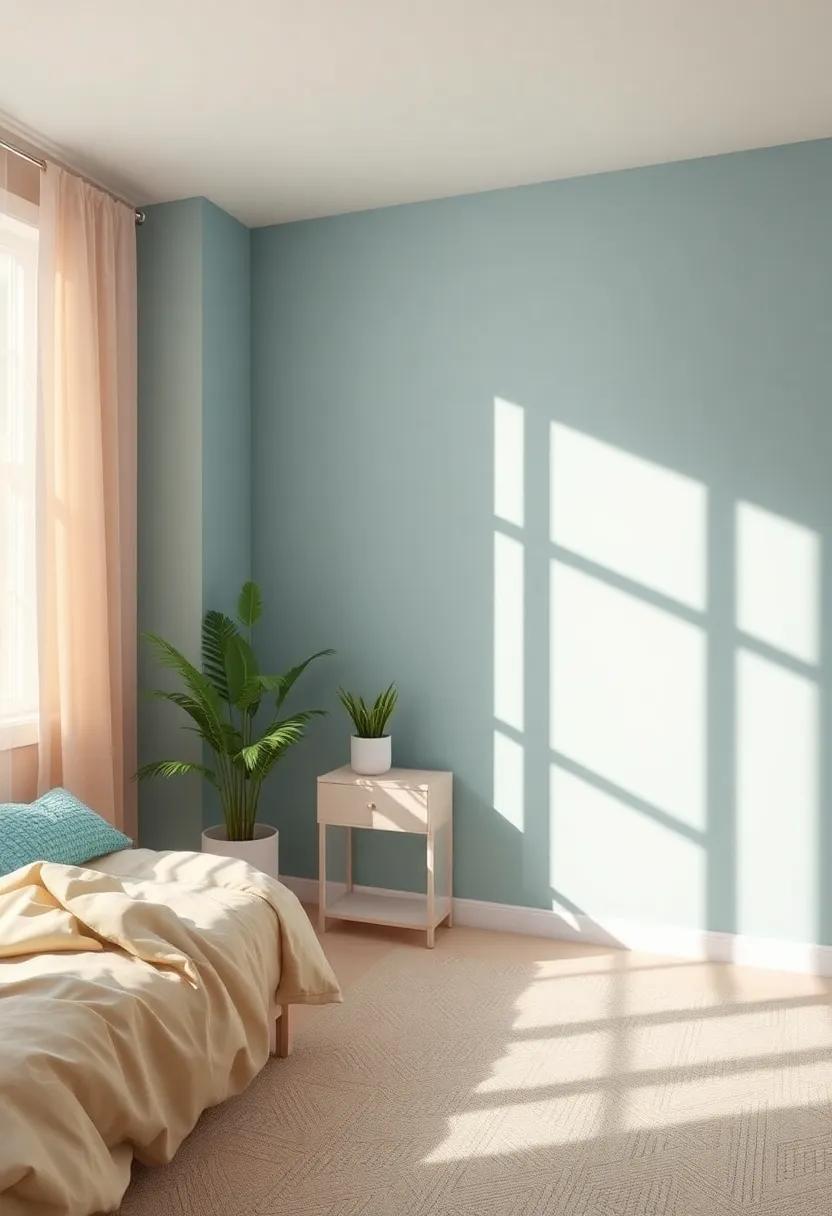
To create an inviting atmosphere that maximizes natural light in a teen’s room, choosing the right color combinations is key. Light shades such as soft whites, pale blues, and light greys can serve as a perfect backdrop, reflecting sunlight and enhancing the overall brightness. Pair these lighter hues with vibrant accents like coral, turquoise, or sunshine yellow to energize the space without overwhelming it.These pops of color can be applied through bedding, curtains, or wall art, creating an engaging yet tranquil environment that caters to a teen’s evolving personality.
Consider using a harmonious palette to create depth and dimension.A combination of mint green with warm ivory, for example, provides a fresh feel that encourages relaxation while beautifully enhancing the natural light filtering through windows.An accent wall in a bold shade, like deep navy or berry, can create a stunning focal point against lighter walls, making the room feel cohesive and stylish. To showcase these combinations visually,refer to a simple guide like ColorHexa for more ideas on colors and their relationships.
Designing a Multi-Functional teen Room: The Power of color Selection
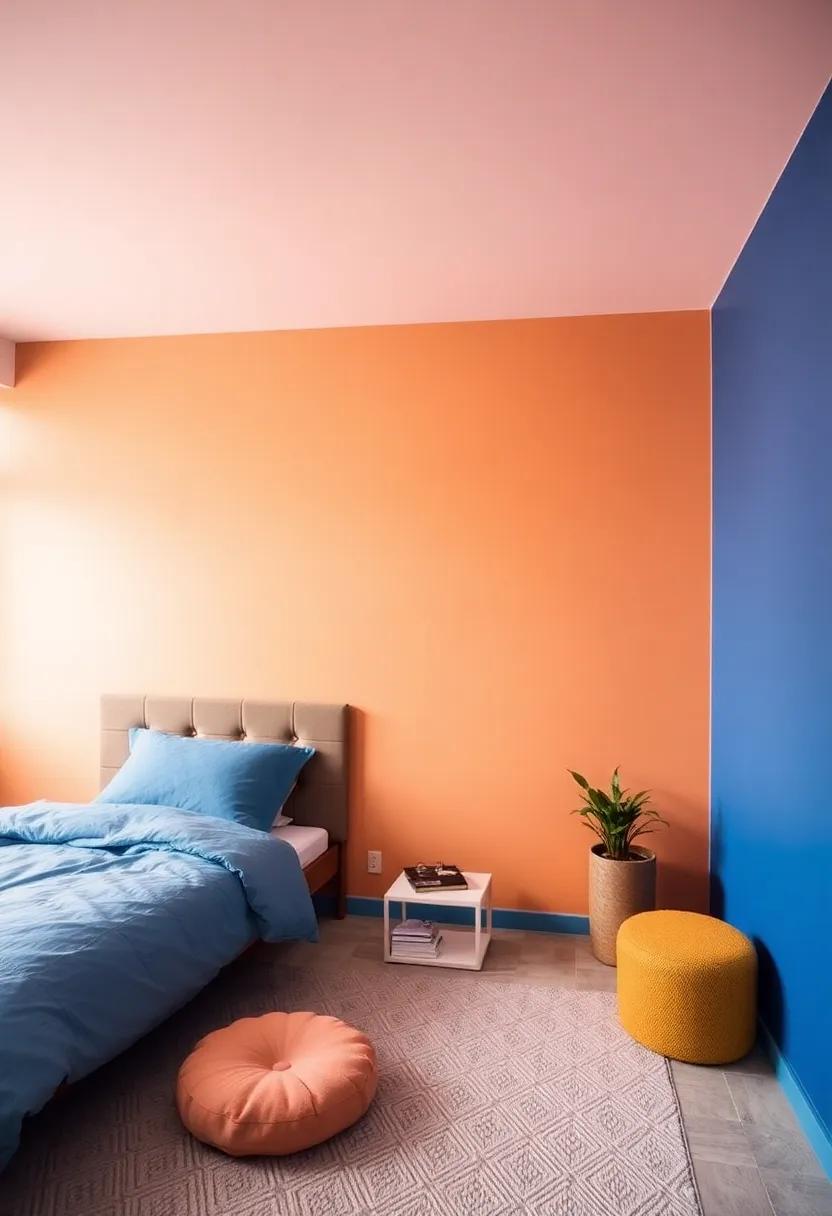
When designing a teen room, the selection of color can drastically influence not just the aesthetic but also the functionality of the space. A vivid color palette can inspire creativity and vitality, making it easier for a teen to study, engage in hobbies, or simply relax. To strike the perfect balance, consider using a mix of bold and neutral shades to foster a versatile environment. For example, vibrant accent walls paired with softer hues can create zones within the room, delineating areas for work, play, and sleep. Think about adding elements such as colorful throw pillows, artwork, or rugs that can easily be swapped out as tastes evolve.
It’s essential to consider how different colors affect mood and productivity. Blues and greens are known for their calming effects, making them excellent choices for study areas, while yellows and oranges can boost energy and creativity in recreational sections. this understanding of color psychology allows for the creation of a balanced room that meets all the diverse needs of a teenager. Explore various online resources, such as Houzz, for inspiration and tips on combining colors effectively in a multi-functional space. Try out different combinations using swatches, and remember that lighting can also alter the perception of colors throughout the day, allowing for even more versatility.
Creating a Themed Room: Color Schemes That Enhance Your Favorite Interests
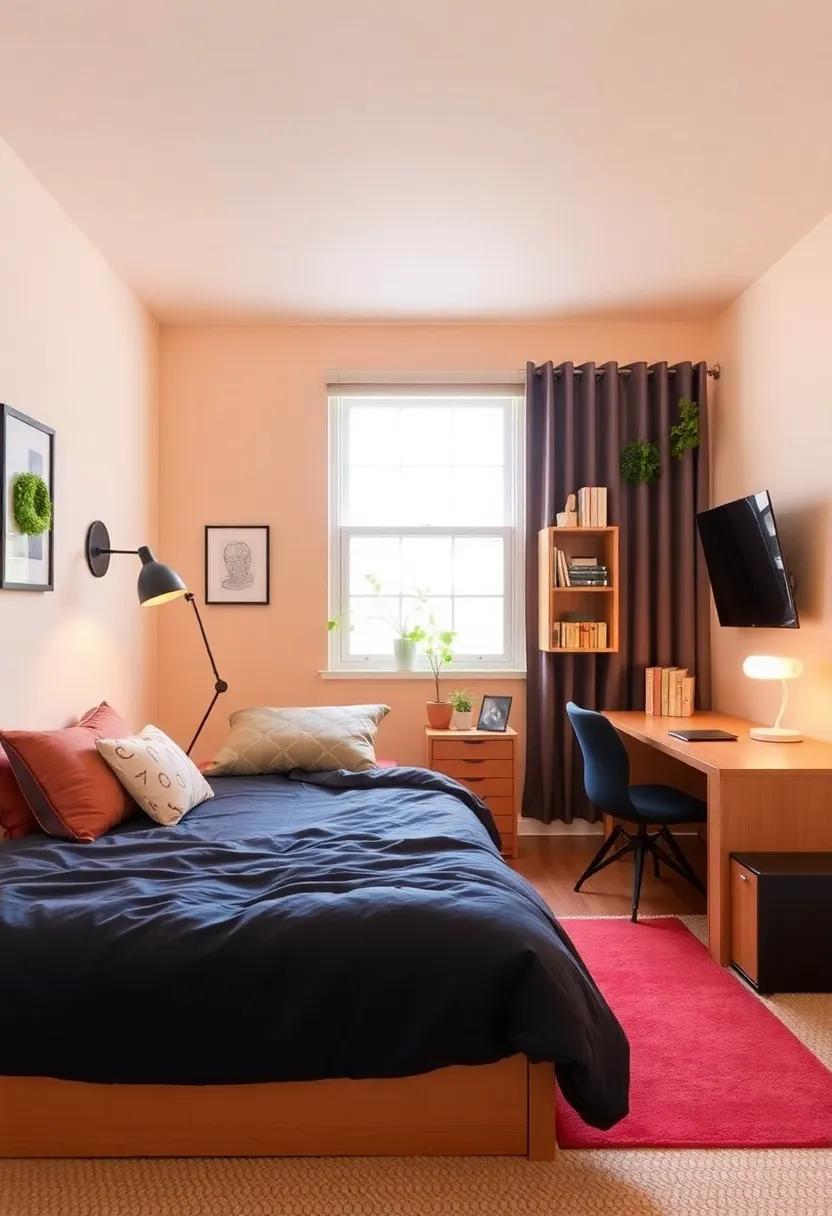
For those inclined towards vibrant creative pursuits like art or music, a color scheme rich in vivid hues can ignite inspiration and energy. Think about combining electric blues, radiant oranges, and lively pinks to create a dynamic environment. To make these colors work harmoniously, focus on layering with neutral accents like whites or grays, allowing your favorite colors to pop without overwhelming the space. Additionally,creating a mood board can definitely help visually align your ideas. Seek inspiration on platforms like Pinterest, where you can explore how different colors play off each other as you craft a room that resonates with your unique personality and interests.
Color Strategies for Increasing Focus and Minimizing Distraction in Rooms

Creating an environment conducive to focus requires careful color selection. Cool hues such as blue and green have been proven to promote concentration and calmness. Consider these striking options for your teen’s room:
- Soft Pastels: Light shades of blue or mint green create a tranquil space, perfect for study and relaxation.
- Dark Accents: A deep navy or forest green can be used as an accent wall, providing depth and encouraging a focused mindset.
- Neutrals and Whites: Complementing brighter colors with whites or grays can foster a minimalist aesthetic, reducing visual clutter and distraction.
Conversely, certain colors may trigger distraction if overused. bright shades such as red or yellow may be energizing but can lead to overstimulation. When incorporating these vivacious colors, it’s essential to do so sparingly. A thoughtful approach might include:
- Accent accessories: Use vibrant decor like cushions or artwork to inject energy without overwhelming the senses.
- Balanced Combinations: Pair bold colors with soothing ones to create a harmonious blend that maintains interest without leading to chaos.
- Natural Elements: Incorporate plants or earthy tones to ground the space and balance out vivid colors, promoting a serene atmosphere.
For more insights on color psychology and its impact on productivity, check out Verywell Mind.
Imagining Your Ideal Fishbowl: A Colorful Exploration of Aquatic Design Elements

To bring your aquatic vision to life, consider incorporating various design elements that reflect rich marine diversity. Here are some ideas to explore:
- Textures: Use soft,flowing fabrics that mimic the movement of water.
- Lighting: Install fixtures that create wave-like shadows, enhancing the sense of depth.
- Wall Art: Choose ocean-themed artwork to immerse yourself in the marine experience.
- Decorative Accessories: Incorporate shells, driftwood, or miniature aquariums for added flair.
For those seeking inspiration on aquatic palettes, consider checking out resources like Color Adobe to discover how different tones can transform your space. With the right combination of elements, you can create an engaging teen room that feels like a vibrant aquatic sanctuary, where creativity flows as freely as ocean waves.
The Conclusion
As we conclude our journey through the dynamic world of teen room color schemes, it’s clear that color is more than just an aesthetic choice; it serves as a powerful tool for self-expression and mood enhancement. From the calming embrace of soft pastels to the energizing pop of bold hues, every color has the potential to transform a simple room into a personal sanctuary.
Embracing vibrant vibes is about understanding the emotions and atmospheres that different shades can evoke and selecting palettes that resonate with individual identities and lifestyles. Whether you’re seeking inspiration for a complete makeover or just a fresh accent, remember that your space should reflect who you are and how you want to feel.
As you embark on this creative endeavor, let your imagination run wild, experiment fearlessly, and don’t hesitate to mix and match until you find the perfect combination that feels just right. After all, your room is a canvas awaiting your personal touch. Now,go forth and paint your world with the vibrancy that only you can create!
 theFASHIONtamer Where Style Meets Space, Effortlessly
theFASHIONtamer Where Style Meets Space, Effortlessly 